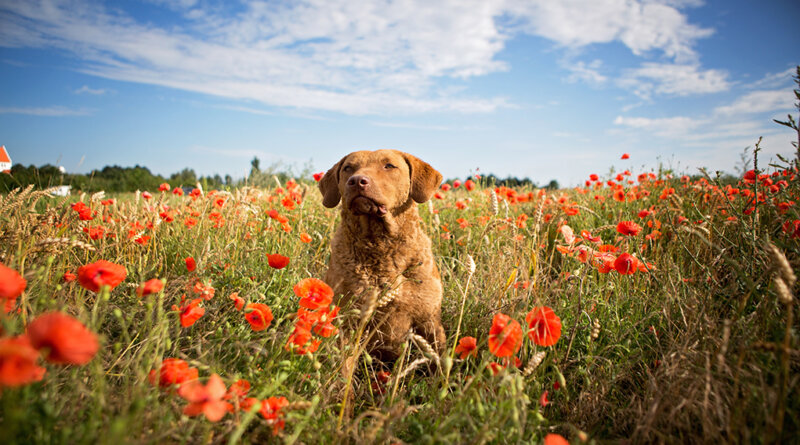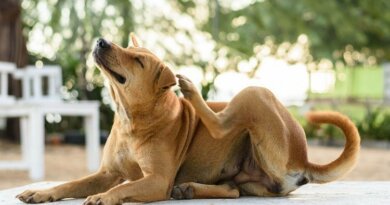Chesapeake Bay Retriever Dog Breed Profile – Top Dog Tips
The Chesapeake Bay Retriever, or Chessie for short, is the Sherman tank of the retriever breed. This Retriever is a hunting dog created to go after geese and ducks.
On the Eastern Seaboard, in the Chesapeake Bay, Chessie Retrievers can tolerate cold temperatures and heavy tides.
They are excellent swimmers that possess a powerful but gentle bite that allows them to carry birds.
Indeed, Chesapeake Bay Retriever is a waterfowling dog that loves to get wet to bring back his feathered quarry.
If you are also a waterfowler and can give the Chessie dog a hunting environment, you two can be a perfect pair!
Significant Characteristics of a Chesapeake Bay Retriever Dog
Unlike any other athletic dog breed, Chesapeake Bay Retrievers are not friendly to strangers, but that does not mean they are bad-tempered.
Chessies are also stubborn and do everything in their way!
Chesapeake Bay Retrievers become excellent swimmers and make their tails a rudder when introduced to water at an early age.
Chesapeake Bay Retrievers don’t make good companion dogs. No matter how much exercise and training you give him, he’s a hunting dog by heart.
But it doesn’t mean that they can’t be a therapy dog or a family pet.
As hunting dogs, they have strong noses that come in handy when participating in fallen games. There are legit stories that they can catch up to 100 ducks a day!
Although stubborn, this Chessie Retriever can do well in obedience games when trained properly to tolerate repetitive actions. Rallies, flyball, and agility are the better choices for them.
Size
The male Chesapeake Bay Retriever stands 23 to 26 inches at the shoulder and can weigh up to 80 pounds. The female Chesapeake Bay Retriever stands only at 21 to 24 inches and weighs 55 to 70 pounds.
Physical Characteristics
The Chesapeake Bay Retriever is a robust and muscular medium-sized dog. The head is brown with a medium stop.
Its jaws are long enough to hold birds and short enough to ensure a powerful grip.
It has a yellowish to an amber set of eyes. Its ears are small and hang loosely side by side.
The teeth meet in a level bite. Its chest is deep and wide with a distinct feature of the hindquarters, often higher than the shoulders.
The Chessie Retriever breed has webbed feet to aid in swimming. Its tail is medium length and has a heavy end.
As a water Retriever, Chessies have water-resistant coats in the same way as the duck’s feathers. The topcoat is thick but short and oily, while the undercoat is dense and woolly.
Their coat provides insulation that allows them to hunt in all types of weather. The oily outercoat and woolly undercoat prevent the cold water from going into their skin.
This oily and woolly coat helps them dry quickly.
The Chessie’s coat is for them to camouflage around the surroundings. It can be any shade of brown, sedge, tan, or dead grass.
The dead grass color has no red tones. It can vary from yellow to tan.
The sedge coat is an almost strawberry blonde with reddish undertones. The brown Chessie is darker and may have red undertones.
On some occasions, Chessies can have white spots on their chest, belly, toes, or at the back of their feet.
Chesapeake Bay Retriever’s Personality and Temperament
A Chesapeake Bay Retriever is naturally bright and happy mixed with bravery, intelligence, impressive work ethic, and alertness. He can make an outstanding watchdog!
He has a strong mind and requires firm training with adults in the household. A leadership with full authority is already enough to minimize Chessie’s behavior.
Chessies have a funny sense of humor, but their stubbornness hinders the entertainment. It’s hard to remove an idea that is around in their heads.
Chesapeake Retrievers are like kids who will bug you over something that they want. They are persistent in getting what they want.
Chessie Retrievers are not fond of barking too much. They are also not considered as the excited type of dog.
This Retriever dog breed is known to be even-tempered.
Chesapeake Bay Retriever loves to plunge in cold water. He loves to swim and retrieve ducks or geese.
Despite having an active lifestyle, this dog breed is surprisingly calm on the inside!
Although Chessies have an independent trait, they can show you that they are eager to learn new things.
RELATED ARTICLE: Why Some Dogs Are More Independent Than Others
They can be reserved and wary of strangers and can become aggressive with new dogs.
Among all the Retriever dog breeds, the Chesapeake Bay Retriever is the most determined and protective.
Grooming Necessities for Chesapeake Bay Retriever
The Chesapeake Bay Retriever dog needs brushing once a week to remove dead hair. As a dog breed that sheds a lot, brushing should be done daily during shedding seasons in spring and fall.
A rubber curry brush is the most advisable brush for Chesapeake Bay Retriever. Don’t use metal brushes for this dog breed because it can damage the dog’s coat texture.
RELATED ARTICLE: Types of Grooming Brushes
When bathing a Chessie Retriever dog, it’s necessary to use a dog shampoo because human shampoos have different pH and can irritate his skin.
Here’s a list of 5 dog shampoos that are mild for any breed, most especially for Chessies:
- Earthbath Ultra-Mild While Cherry Puppy Shampoo – Tearless & Extra Gentle for Puppies’ Sensitive Skin
- Dog Argan Shampoo-Conditioner – 20oz Clinical Vet Formula Wash for All Pets Puppy & Cats – Made with Aloe Vera for Relieving Dry Itchy Skin (Argan Shampoo)
- Wahl Gentle Puppy Shampoo for Pets – Cornflower & Aloe with 100% Natural Ingredients for Grooming Dirty Dogs
- Isle of Dogs Tearless Puppy Shampoo
- Vet’s Best Hot Spot Itch Relief Shampoo for Dogs | Relieves Dog Dry Skin, Rash, Scratching, Licking, Itchy Skin, and Hot Spots
Note: Brush his coat first before anything else. Apply dog shampoo after wetting the hair and lather in outward and downward directions.
How To Feed a Chesapeake Bay Retriever
Since the Chessie Retriever is a medium-sized dog, he’s required to have a daily amount of 2 to 2.5 cups of dry dog food during breakfast and dinner.
Any high-quality dog food is suited for a Chesapeake Retriever. And he needs 20 percent of protein and 10 percent of fat every day since he’s an active dog.
Chicken and lambs may be a good option for a protein source, but novel proteins like salmon, duck, and venison are the best for the overall health of this Retriever dog breed.
The Lifespan of a Chesapeake Bay Retriever Dog Breed
Chesapeake Bay Retriever dog can live up to 10 years. Some may go beyond 15 years if in good health condition.
Chessie dogs do lots of physical activities, running and moving so much. So, make sure you will have him screened for possible hip and elbow problems.
The American Chesapeake Club also recommends heart examinations.
Just recently, degenerative myelopathy, a neurological disease, has been found out to destroy the spinal cord tissues of the Chesapeake Retriever and can eventually prevent him from walking.
Also, even if food is necessary, avoid overfeeding him. Overweight dogs have a higher possibility of experiencing joint pains.
Living Arrangements for Chesapeake Bay Retriever
Chesapeake Bay Retrievers would love to be in a yard for their daily runs and plays. But if you live in an apartment, you’ll need to take out your Chessie at least twice a day or more.
It’s a plus for Chessie Retrievers if you have ponds or anything that has water. They can also go hiking!
They want to take part in your active lifestyle but don’t forget to give them breaks now and then if you’re planning to have an extensive exercise with them.
Chessie Retrievers are for places that can offer them swimming and hunting. However, they can compromise with the city life provided that they can have physical activities.
The most important thing a Chesapeake Bay Retriever needs from you is attention and love. You need to invest time in training, exercises, and playing with him.
RELATED ARTICLE: Adopting a Dog for Your Lifestyle
Relationship Between Chesapeake Bay Retrievers and Children with Other Pets
Chessies love to get along with kids, but they would rather walk out than be a target of their harassment.
This Retriever dog can be possessive of their food and toys. This trait makes them not suitable in a home with younger children.
Many Chessie breeders won’t sell this Retriever dog breed to people with children younger than eight years old.
However, an adult Chessie who is already familiar with children is a match for families with youngsters.
They can also get along with other pets in the house when being socialized at an early age.
RELATED ARTICLE: Benefits of Kids Growing Up With Pets
Chesapeake Bay Retriever Dog Breed History
An American ship in 1807 rescued the crew and cargo from a shipwreck on the coast of Maryland. Along with two Newfoundland puppies.
They were named Sailor and Canton. Sailor is a dingy red male, and Canton is a black female.
Sailor found a home with John Mercer of West River and Canton with Dr. James Steward of Sparrow’s Point.
Both of them acquire the reputation of being excellent water dogs, most especially in duck hunting. Their ability, as well as their golden or amber-colored eyes, were handed down to their offspring.
Though there was no record of mating, 70 years later, in 1877, the strains from both western and eastern shores of Maryland met at a Poultry & Fanciers Association in Baltimore.
The similarities are uncanny! They are known as “The Chesapeake Bay Ducking Dog.”
According to the records, the puppies at the Carroll Island Kennels were a combination of Sailor and Canton. From there, it began to spread out all over the region.
Chesapeake Retrievers retrieve ducks from the Chesapeake Bay that extends from Maryland to Virginia.
They can withstand freezing temperatures of the water in the Bay.
The Chesapeake Bay is the home of many waterfowl during winter migrations.
Chesapeake Bay Retriever Recognition
In 1884, a particular breed of Chesapeake was well-known for its strength in the icy waters of Chesapeake Bay.
The American Chesapeake Club was founded in 1918 and gained its license in retriever trial in 1932.
Today, a pair of cast-iron statues of Chesapeake Bay Retrievers guard the front door of the Chesapeake Bay Maritime Museum located at St. Michael’s, Maryland.
Breeding Chesapeake Bay Retrievers
Chesapeake Bay Retrievers have an average of 7 to 10 puppies. These numbers may vary as there is little to no information on the specific quantity of litter a Chessie can produce.
Generally, the litter size depends on the dam’s age, health, size, and fertility. It will also depend on the stud’s sperm quality.
Chesapeake Retrievers are not prone to birthing difficulties. Dystocia is more common in dog breeds like Pugs, Bulldogs, and Boston Terriers.
But you must still be aware of any problems your Chessie may encounter during her pregnancy. Be sure to give her vet assistance if signs of birthing problems will occur.
Regular vet appointments would be beneficial to her general health.
RELATED ARTICLE: Guide on Pregnant Dogs
How To Own a Chesapeake Bay Retriever Dog?
From Rescue Groups and Animal Shelters
Finding a Chesapeake Bay Retriever in your local shelters can be so rare. With that, here are some of the breed-specific rescue groups that are doing a great job in helping you to find one:
Adopting a dog is the most fulfilling act for everyone!
Purchasing From a Trusted Breeder
When looking for a Chesapeake Bay Retriever puppy, it’s essential to do your research and look for a legit and responsible breeder.
These breeders should provide the parent’s health clearances. The puppies with their mother should come from a healthy environment.
Note: Chesapeake Bay Retriever puppies must be at least eight weeks old before being released for adoption.
The American Chesapeake Club can be a good start in finding legit Chesapeake Retriever breeders.
Other Dog Breeds Aside from Chesapeake Bay Retriever
If you are still new in the world of fur parenting, you may become hesitant in getting a Chesapeake Bay Retriever as you may think that they are too much for you and may not fit with your current lifestyle.
With that, you may opt to get other dog breeds that can be a good match for you. You can try to consider getting these dog breeds:
READ NEXT: Tips on How To Choose Your Next Pet
Related










